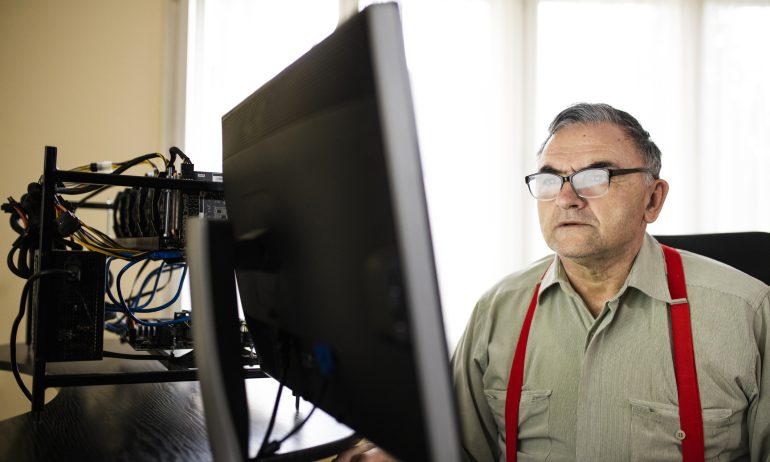How Many Bitcoins Are There in 2024?

Many or all of the products featured here are from our partners who compensate us. This influences which products we write about and where and how the product appears on a page. However, this does not influence our evaluations. Our opinions are our own. Here is a list of our partners and here's how we make money.
The investing information provided on this page is for educational purposes only. NerdWallet, Inc. does not offer advisory or brokerage services, nor does it recommend or advise investors to buy or sell particular stocks, securities or other investments.
About 19.6 million Bitcoins are in circulation as of 2024.
Only 21 million bitcoins can ever be mined — but projections say the last won't be mined until around 2140.
A major constraint on how many bitcoins there are is the block reward halving process — and a halving event is expected in April 2024.
Bitcoin (BTC) is still the largest and most valuable cryptocurrency on the market by a substantial margin. The price of one Bitcoin is over $70,000, and its market cap is slightly over $1.3 trillion. To illustrate Bitcoin's popularity, the second-largest cryptocurrency, Ethereum, is priced at about $3,500 per coin, and its market cap is about $420 billion. Bitcoin has remained on top of the market.
One reason Bitcoin has become so valuable is its limited supply. Bitcoin’s blockchain protocol established that only 21 million Bitcoins will ever be minted — that is, released to the public. To date, about 19.6 million BTC have been minted .
But don't expect Bitcoin to reach its cap soon. Its protocol includes measures that will delay the process, and projections estimate that the last Bitcoins won’t be minted until 2140.
NerdWallet rating 4.9 /5 | NerdWallet rating 5.0 /5 | NerdWallet rating 4.1 /5 |
Fees $0 per online equity trade | Fees $0 per trade | Fees $0 per trade |
Account minimum $0 | Account minimum $0 | Account minimum $0 |
Promotion None no promotion available at this time | Promotion None no promotion available at this time | Promotion Get up to $700 when you open and fund a J.P. Morgan Self-Directed Investing account with qualifying new money. |
How are Bitcoins minted?
The Bitcoin blockchain network runs on a proof-of-work mechanism, which rewards cryptocurrency miners for validating transactions. Each transaction block on the network contains 1,400 to 2,300 transactions, and miners are rewarded a flat rate of 6.25 BTC for each new block added to the blockchain ledger.
Bitcoin adds a new block to the ledger about once every 10 minutes. This means that, on average, about 144 transaction blocks are added to the blockchain every day. Because miners are rewarded 6.25 BTC per block, about 900 BTC coins are minted each day.
Miners also receive a small amount of Bitcoin through transaction fees, so they will typically prioritize transactions with the highest fees to maximize their reward. Transaction fees vary based on how complex the transactions are in each block. Generally, the more complex the transaction, the higher the fee will be.
Miners are essential to the blockchain because validating transactions in each block helps keep the network secure.
What is Bitcoin halving?
When Bitcoin reaches its cap and all 21 million BTC have been minted, miners will no longer receive a reward for validating transactions. This presents a concern for Bitcoin users because if miners aren’t incentivized to validate transactions, they may stop mining. Without miners validating transactions, network security would suffer and BTC could lose its value. Miners would still receive transaction fees for validating transactions, but the question is whether BTC would be valuable enough to make the transaction fees worth it.
To put this off, Bitcoin's underlying code includes a feature that will significantly delay the point at which the cap will be reached: halving.
The reward for mining Bitcoin is cut in half every 210,000 blocks mined. Recall that about 144 blocks are mined each day, so it shakes out to a halving every four years. When Bitcoin was released in 2009, the reward for miners to validate each transaction block was 50 BTC. The most recent halving occurred in 2020, when the reward was reduced from 12.5 BTC to 6.25 BTC. In April 2024, the next scheduled halving will occur, and the reward will be reduced to 3.125 BTC.
By reducing the amount of Bitcoin that can be minted every four years, the cryptocurrency aims to reduce inflation risk by promoting scarcity. If the amount of Bitcoin available is reduced and demand stays the same, it should drive the value of each BTC higher.

When will Bitcoin reach its cap?
With the current halving schedule, Bitcoin will not reach its cap until 2140. While Bitcoin investors today may rest easy knowing this is not likely to become a major problem during their lifetime, concerns about the future of Bitcoin remain. The Bitcoin community has discussed increasing the supply limit or perhaps changing the halving schedule to further delay reaching the cap.
However, doing so would likely result in a hard fork, meaning that a blockchain would have to be created that is separate from the original Bitcoin protocol. Ultimately, the success or failure of Bitcoin after it reaches the cap will depend in large part on whether transaction fees are high enough to keep miners around to validate transactions. But this will likely be a problem for future generations of Bitcoin investors.
The author held no positions in the aforementioned investments at the time of publication. The editor owned Bitcoin.
On a similar note...






